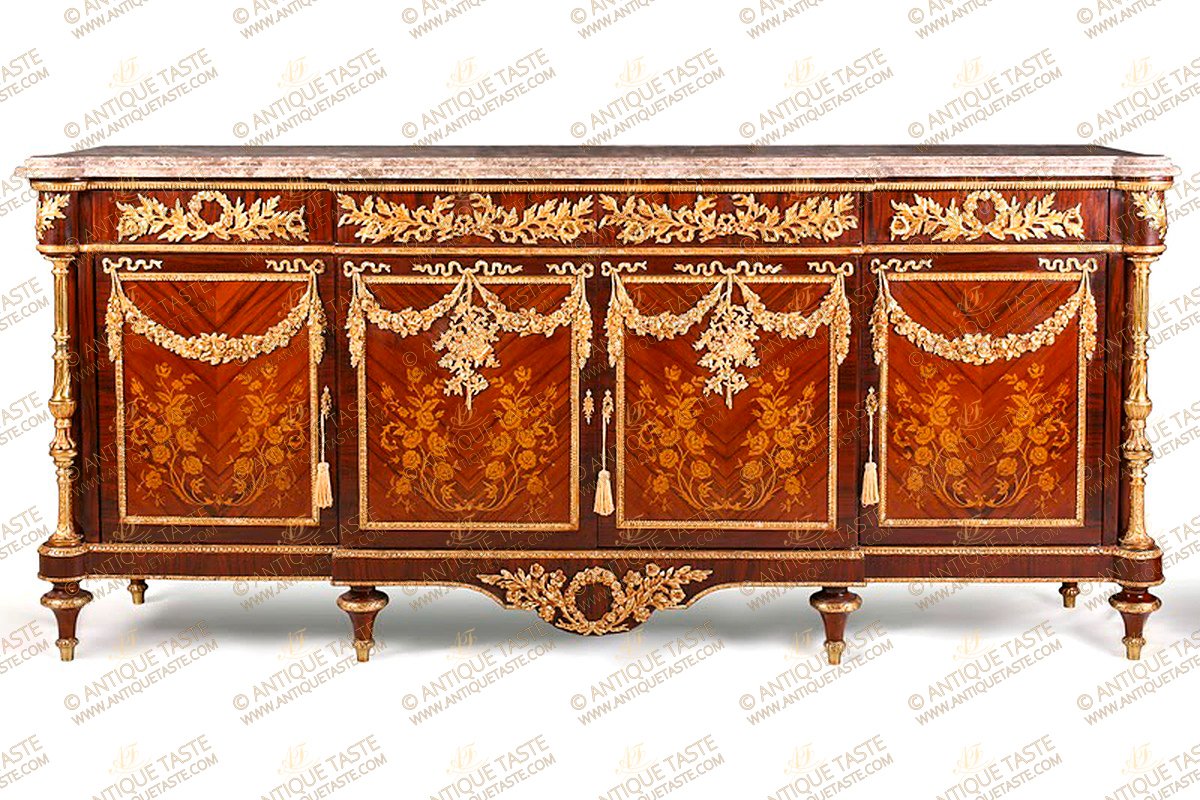Ref#1648-B | Description
A Grand and Royal French Louis XVI style ormolu-mounted veneer and marquetry inlaid Buffet À Vantaux after the model Frédéric Durand and Sons, based on a model by Martin Carlin, Paris, Last Quarter 19th Century,
The large two meter breakfront shaped eared marble top above a conforming case set with frieze drawers ornamented with swags and ribbon-tied loose bouquets pierced interlaced laurel garlands, the sides similarly decorated,
The top drawers frieze is surmounting four cupboard doors. Each door is decorated with an ormolu keyhole escutcheon and inlaid with naturalistic flowers marquetry patterns, the paneled doors hung with ormolu blossoming pendant garlands, the sides are sans traverse veneer inlaid,
The angles with astonishing gilt-ormolu turned fluted colonnettes angle supports called "chinoises" over an arbalette shaped apron centered with an ormolu ribboned-shape blossoming floral wreath and raised on ormolu decorated six toupie feet.
The luxurious buffet is a part of a dining set.
Ref#1648-B
240 x 55 x 105 cm
Martin Carlin:
Martin Carlin was born in Germany and emigrated to Paris to become an ébéniste. He settled there with other German and Flemish craftsmen and took employment in the workshop of Jean-François Oeben, whose sister he married. Inventories made after Carlin's death show that the ébéniste and his wife lived modestly in a five-room apartment in the Faubourg Saint-Antoine, an unfashionable quarter of Paris, with simple furniture, a few pastel portraits, and a black lacquer clock. Few of Carlin's wealthy clientele would have cared to venture into this area, and Carlin thus sold his works exclusively to middlemen such as the marchands-merciers Simon-Philippe Poirier and Dominique Daguerre.
Carlin was particularly known for his furniture decorated with Sèvres porcelain plaques, which he began to make in 1765, following designs supplied by the dealer Poirier. Although he made a certain number of larger pieces, secrétaires, tables, and commodes, Carlin's most popular works were small, portable, and extremely elegant items such as small tables, music stands, and jewel cabinets. A master of the Neoclassical style, he also produced works set with lacquer panels and veneers of mahogany.
Frédéric Louis Durand & Fils:
Gervais Durand was born in Paris on July 30, 1839. After 1870 he was a cabinet maker rue de la Cerisaie, number 12. He was so successful that in 1878 he had to move to another location, 23 rue Beautreillis. He won the silver medal at the world fair in 1889. Durand was both draughtsman and carpenter for his style furniture. He created beautiful copies of the great 18th century designers. In 1898 the company settled in the Hotel de Sully located 62 rue Saint-Antoine. In 1902, Gervais partnered with his son under the name “Durand et Fils” (Durand and Son). His son Frédéric Louis (1874-1933) took over the company when his father died in 1920. He himself partnered with his own son Pierre until the company closed out in 1933.
Tags
- #Frédéric-Durand-et-Fils-Buffet | #Martin-Carlin-style-Buffet | #Verni-Martin-Buffet | #Marquetry-Buffet | #Ormolu-Mounted-Buffet | #Hand-Painted-Louis-XV-Chest-Of-Drawers | #Louis-XV-Vernis-Matin-Furniture | #Commode-of-Chamber-Louis XVI | #Joseph Stöckel-Commode | #Guillaume-Benneman-Cabinet | #François-Linke-Vernis-Martin-Chest | #French-Louis XVI-Sideboard | #Parquetry-and-Marquetry-Bahut | #French-Bahut | #Japanese-lacquer-and-ebony-Sideboard | #Japanese-Black-small-Buffet | #Jean-Henri-Riesener-Bahut | #Empire-Style-Cabinet | #Napoleon-Style-Sideboard | #Napoleon-Second-Empire-Furniture | #Francois-Linke-Display-Cabinet | #Leon-Message-ormolu-design | #Haentges-Frères-Commode | #French-style-Cartonnier | #French-style-Cupboard | #French-Bombe-Commode | #19th Century Transitional style Commode | #Jean-François Leleu Commode | #Napoleon III Commode | #Napoleon III style Cabinet | #Napoleon III Side Cabinet | #Napoleon III Sideboard | #Meuble A Hauteaur D'appui | #Commode a vantaux | #Antoine Gaudreaux Commode | #Jean-Henri Riesener commode | #Marie-Antoinette commode | #Charles Cressent commode | #Maison Millet commode | #Pierre Antoine Foullet commode | #André Charles Boulle commode | #French style commode | #Louis XV commode | #Louis XIV commode | #Louis XVI commode

